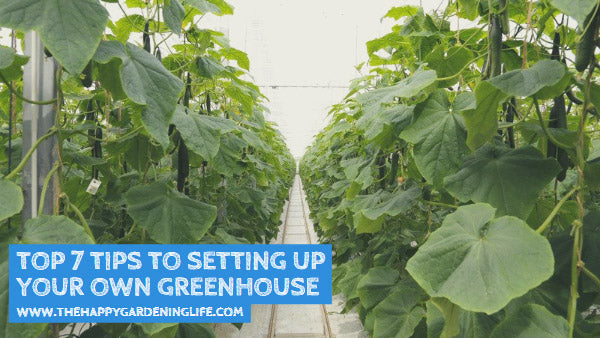
Top 7 Tips to Setting Up Your Own Greenhouse
Share
 Having your own greenhouse is simply awesome. It gives you full control over the growing environment of your plants—from the temperature and humidity, to the irrigation, lighting and shade. A greenhouse allows you to make the adjustments you need so your garden plants can truly grow and develop naturally.
Having your own greenhouse is simply awesome. It gives you full control over the growing environment of your plants—from the temperature and humidity, to the irrigation, lighting and shade. A greenhouse allows you to make the adjustments you need so your garden plants can truly grow and develop naturally.
If you're thinking about setting up a greenhouse, you must take a few factors into consideration. It is important to learn about the different greenhouse types, their specific purposes, as well as the materials needed so you can choose the right one that will really suit the conditions in your area.
To help you get started, read these 7 helpful tips below on how to set up your own greenhouse. Feel free to share this blog post with your buddies on Facebook, Twitter and Pinterest today!
Got some great tips on greenhouse building? Leave your comments below!
7 Tips to Setting Up Your Own Greenhouse
1. Extended scope
The biggest advantage of a greenhouse is that it allows you to grow plants and crops that need more shelter and higher temperatures than are found in the open garden. Greenhouses are season-stretchers – earlier springs and later autumns. For summer food, think tomatoes, peppers, aubergines. In winter, they can be filled with hardy oriental greens.
Sowing seeds, growing on plug plants, propagation, growing cut flowers and fresh food, and protecting plants on chilly spring nights are just some of the other advantages. It’ll also help you keep you (and your spirits) going in a tempestuous growing season.
2. Site in sunshine
Finding the optimum spot for a greenhouse is vital. Sunlight, as much as possible, on all sides, is crucial. For a long and narrow structure, an east-west orientation as ideal, but if you can’t, don’t fret. Avoid going near structures casting shadows such as walls/fences/hedges/buildings, and keep out from under trees.
3. Sky’s the limit
Buying a new greenhouse is the easy bit; deciding which one is harder. There are designs and styles to suit every taste and budget, from traditional to ultra-modern. Let a search engine do the legwork, but follow the golden rule: buy the biggest and best you can afford – you’ll never regret it. Cheap, flexible plastic greenhouses will just blow away in the wind.
4. Firm foundations
A greenhouse must stand on a solid, well-built base, and good suppliers will advise on its exact (non-negotiable) dimensions. Bases can be made of brick, concrete, timber (such as untreated hardwood sleepers) or a combination. Recycled plastic lumber is worth a look: it’s maintenance-free, available in various colours, and will never, ever rot.
5. Growing space
If your greenhouse is built on soil, you can grow straight into it, watering and tending plants as necessary, working from a central path. On impermeable surfaces, use pots and growbags, which can be stood on tiered timber or metal staging, or build raised beds. Or have a combination of all three.
6. Vents
All greenhouses need vents to allow hot, rising air to move out, and cool air to move in, especially in summer. Check with the manufacturer for the optimum number of roof vents (fit automatic openers if you’re out all day). Don’t scrimp on investing in louvres, which draw in cooler air at the base of the greenhouse and keep up a good, constant flow, creating better growing conditions.
7. Green heat
Greenhouses are terribly inefficient (despite bubble-wrap) at holding onto heat you’ve paid for. Nowadays, my unheated lean-to relies solely on free and renewable sunshine. If you must use heat, go electric – it creates better growing conditions anyway – and switch to a 100 per cent renewable supplier first.
Article Source: telegraph.co.uk
